

Literal v. Inferential Reading Questions. There is a direct relationship between a question asked about a reading passage and the type of answer required.
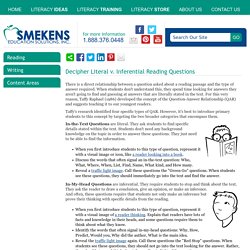
When students don't understand this, they spend time looking for answers they aren't going to find and guessing at answers that are literally stated in the text. For this very reason, Taffy Raphael (1986) developed the concept of the Question-Answer Relationship (QAR) and suggests teaching it to our youngest readers. Taffy's research identified four specific types of QAR. However, it's best to introduce primary students to this concept by targeting the two broader categories that encompass them. In-the-Text Questions are literal. When you first introduce students to this type of question, represent it with a visual image or icon, like a reader looking into a book.
In-My-Head Questions are inferential. Reader to draw a conclusion, give an opinion, or make an inference. Bringing it all together Integrate the QAR language into your read alouds. Engl teach read view comprehension. Comprehension Teaching the Super Six. Inference. Language Arts The Question-Answer Relationship strategy helps students understand the different types of questions.
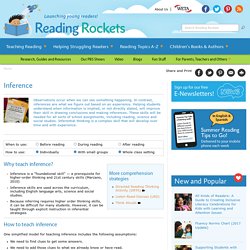
By learning that the answers to some questions are "Right There" in the text, that some answers require a reader to "Think and Search," and that some answers can only be answered "On My Own," students recognize that they must first consider the question before developing an answer.See Question-Answer Relationship strategy > Into the Book has an interactive activity that helps young children learn about inferring. In the interactive, students try to infer meaning in letters from virtual pen pals. They try to answer two questions: "WHERE is your pen pal?
" Riddles are one way to practice inferential thinking skills because successful readers make guesses based on what they read and what they already know. BrainPop offers several activities for teaching inference, and they offer resources for teachers and parents.See inference activities > Math Science Social Studies. The Digital Connection – Visual Literacy - The Digital Connection. Excellent-book-of-graphic-organizers. Golda Meir School offers an array of Gifted and Talented programs and services including Project Lead the Way and extended local, regional, national and international field trips.
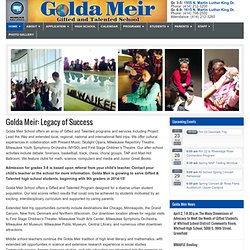
We offer cultural experiences in collaboration with Present Music, Skylight Opera, Milwaukee Repertory Theatre, Milwaukee Youth Symphony Orchestra (MYSO) and First Stage Children’s Theatre. Our after-school activities include debate, forensics, basketball, track, chess, choral groups, TAP and Mad Hot Ballroom. We feature clubs for math, science, computers and media and Junior Great Books. Admission for grades 3-8 is based upon referral from your child’s teacher. Contact your child’s teacher or the school for more information. Golda Meir School offers a Gifted and Talented Program designed for a diverse urban student population. Extended field trip opportunities currently include destinations like Chicago, Minneapolis, the Grand Canyon, New York, Denmark and Northern Wisconsin. Graphic Organizers for Reading Comprehension. Reading Response Forms and Graphic Organizers. Independent reading is a key component of my reader’s workshop and the favorite time of day for many of my students.
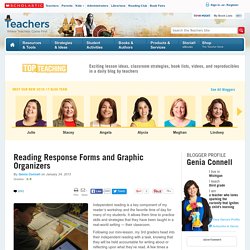
It allows them time to practice skills and strategies that they have been taught in a real-world setting — their classroom. Following our mini-lesson, my 3rd graders head into their independent reading with a task, knowing that they will be held accountable for writing about or reflecting upon what they’ve read. A few times a week, this task involves completing a reading response sheet in their reading binders. This week I will share with you a few of the response forms and graphic organizers that I created for my students to use with fiction throughout the year. These forms are used one to three times a week in my room, and they take about 15 minutes to complete. Reading Binders: Where It All Begins My student’s reading binders are definitely a work in progress. Download reading log by clicking on the image above. Making Connections Visualizing Asking Questions/Wondering. Reading Graphic Organizers and Printables.
Free Teaching Resources - Graphic Organizers. 10 Infographics on Books and Reading. Sssssh.
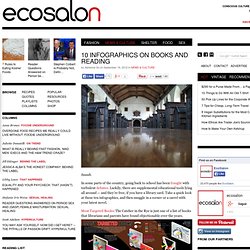
In some parts of the country, going back to school has been fraught with turbulent debates. Luckily, there are supplemental educational tools lying all around — and they’re free, if you have a library card. Take a quick look at these ten infographics, and then snuggle in a corner or a carrel with your latest novel. Most Targeted Books: The Catcher in the Rye is just one of a list of books that librarians and parents have found objectionable over the years.
Orwell Vs. The DNA of a Successful Book: Surprisingly, books with a female protagonist are more likely to be successful. Teaching Us to Read Again: E-readers may be our ticket back to a literate public. Ray Bradbury Predictions Fulfilled: Science fiction’s predictive powers are truly amazing. Battle of the Bookworms: In this digital age, e-readers might be overpowering traditional readers. Do Self-Published Authors Make Money? The Top 10 Most Read Books In the World: Over the last 50 years, Harry Potter has outpaced Anne Frank. Mod08_four_roles.